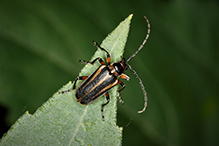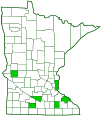double-lined longhorn beetle
(Brachysomida bivittata)
Conservation • Description • Habitat • Ecology • Distribution • Taxonomy
|
|
||||||||||||||
Description |
Double-lined longhorn beetle is a small flower longhorn beetle, ¼″ to 7 ⁄16″ in length. The overall coloration is highly variable, making identification difficult. The head may be entirely black, orange with a black stripe between the eyes, or entirely orange. The compound eyes are always black. The face slants forward or is nearly vertical. The antennae are long, black, thread-like, and at least half as long as the body. The base of each antenna is not surrounded by the compound eye. The upper thoracic shield (pronotum) is bell-shaped, narrow at the front, widest at the base. It may be entirely black, orange with two small or large black spots, or entirely orange with no black markings. The hardened wing covers (elytra) taper evenly from the base to the blunt tip, making the body appear broad-shouldered. They may be all black or black with a pale longitudinal stripe from the shoulder to the tip and a pale stripe at the inner margin where the elytra meet. The stripes may be narrow and well-defined, broad and diffuse and almost completely obscuring the black background, or anywhere in between these two extremes. On each leg the third and largest segment (femur) is orange with black at the tip and the base. The fourth segment (tibia) is black. The last part of each leg (tarsus), corresponding to the foot, is black. The tarsus has five segments but the fourth segment is minute and is concealed within the lobes of the heart-shaped third segment, making it appear that there are only four segments. |
Size |
Total length: ¼″ to 7 ⁄16″ |
Similar Species |
Habitat |
|
Ecology |
Season |
April to July |
Behavior |
|
Life Cycle |
|
Larva Food |
|
Adult Food |
Nectar and/or pollen of flowers |
Distribution |
||
|
Sources |
|
| 8/12/2024 | ||
Occurrence |
||
|
||
Taxonomy |
|
Order |
Coleoptera (Beetles) |
Suborder |
Polyphaga (Water, Rove, Scarab, Long-horned, Leaf, and Snout Beetles) |
Infraorder |
Cucujiformia |
Superfamily |
Chrysomeloidea (leaf beetles and allies) |
Family |
Cerambycidae (longhorn beetles) |
Subfamily |
Lepturinae (flower longhorn beetles) |
Tribe |
Rhagiini |
Genus |
Brachysomida |
Superfamily |
|
Subordinate Taxa |
|
|
|
Synonyms |
|
Acaemops bivittatus Acmaeops bivittata Acmaeops bivittatus Acmaeops fusciceps Acmaeops incertus Acmaeops nigripennis Acmaeops oblongus Acmaeops varians Brachysomida fusciceps Brachysomida incertus Brachysomida nigripennis Brachysomida oblongus Brachysomida varians Gaurotes bivittatus Gaurotes fusciceps Gaurotes nigripennis Gaurotes oblongus Leptura bivittata |
|
Common Names |
|
double-lined longhorn beetle |
|
Glossary
Elytra
The hardened or leathery forewings of beetles used to protect the fragile hindwings, which are used for flying. Singular: elytron.
Femur
On insects and arachnids, the third, largest, most robust segment of the leg, coming immediately before the tibia. On humans, the thigh bone.
Pronotum
The exoskeletal plate on the upper side of the first segment of the thorax of an insect.
Tarsus
On insects, the last two to five subdivisions of the leg, attached to the tibia; the foot. On spiders, the last segment of the leg. Plural: tarsi.
Tibia
The fourth segment of an insect leg, after the femur and before the tarsus (foot). The fifth segment of a spider leg or palp. Plural: tibiae.
Visitor Photos |
||
Share your photo of this insect. |
||
This button not working for you? |
||
Alfredo Colon |
||
 |
|
|
MinnesotaSeasons.com Photos |
||
|
||
|
||

Slideshows |
|

Visitor Videos |
||
Share your video of this insect. |
||
This button not working for you? |
||
|
Other Videos |
||
|

Created: 9/26/2018 Last Updated: © MinnesotaSeasons.com. All rights reserved. |


